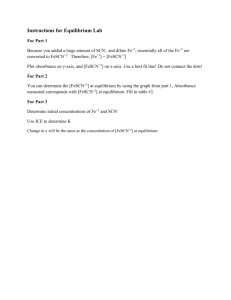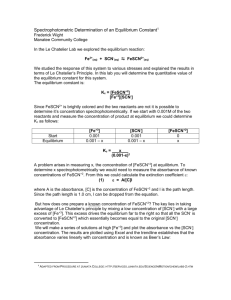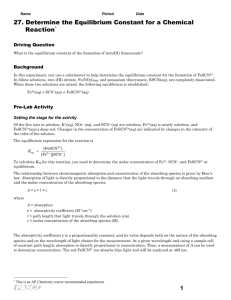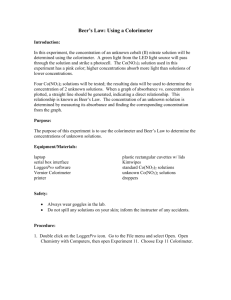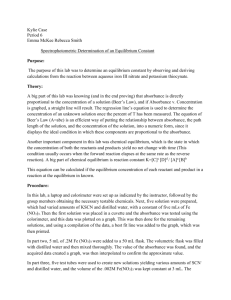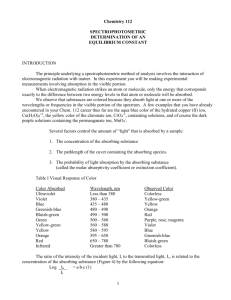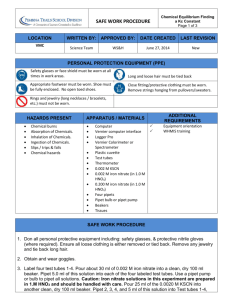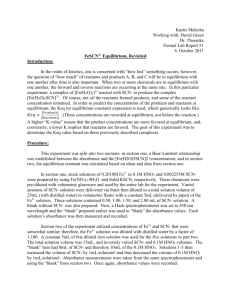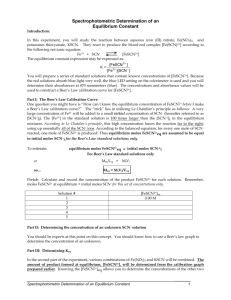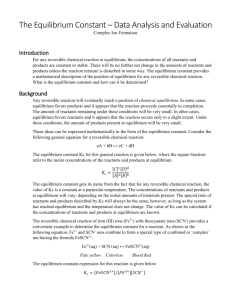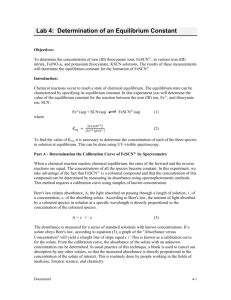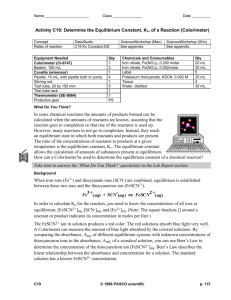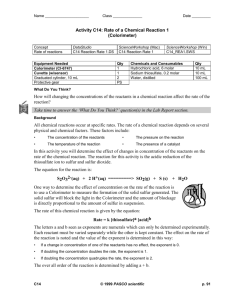Purpose: The purpose of this lab is to calculate Kc, the equilibrium
advertisement
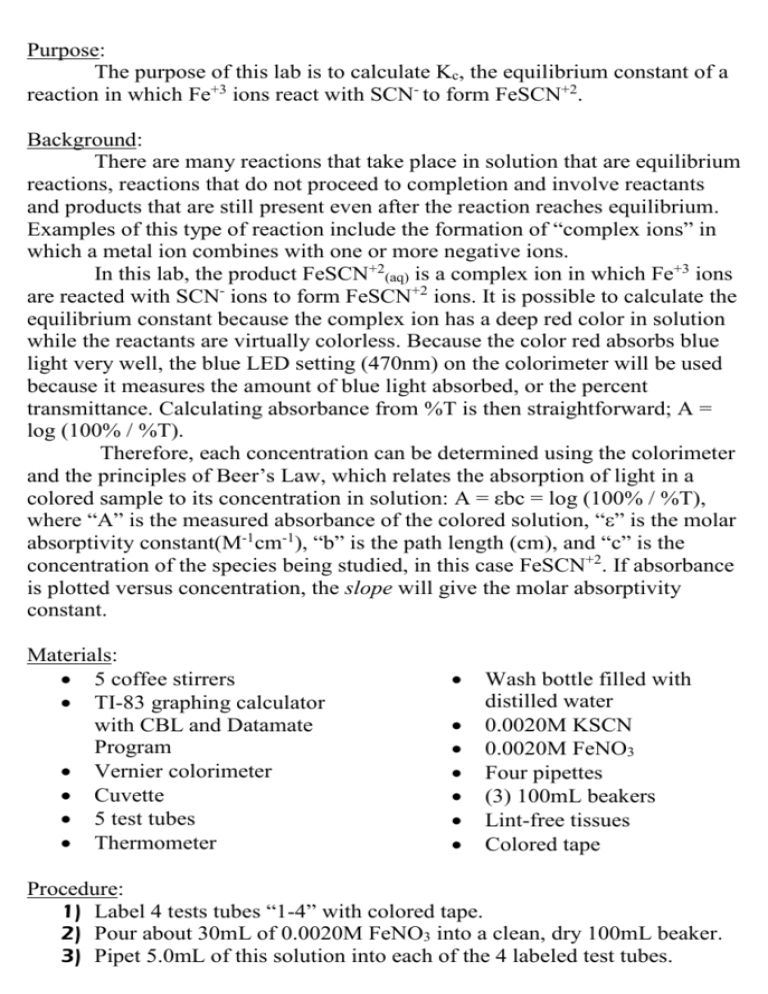
Purpose: The purpose of this lab is to calculate Kc, the equilibrium constant of a reaction in which Fe+3 ions react with SCN- to form FeSCN+2. Background: There are many reactions that take place in solution that are equilibrium reactions, reactions that do not proceed to completion and involve reactants and products that are still present even after the reaction reaches equilibrium. Examples of this type of reaction include the formation of “complex ions” in which a metal ion combines with one or more negative ions. In this lab, the product FeSCN+2(aq) is a complex ion in which Fe+3 ions are reacted with SCN- ions to form FeSCN+2 ions. It is possible to calculate the equilibrium constant because the complex ion has a deep red color in solution while the reactants are virtually colorless. Because the color red absorbs blue light very well, the blue LED setting (470nm) on the colorimeter will be used because it measures the amount of blue light absorbed, or the percent transmittance. Calculating absorbance from %T is then straightforward; A = log (100% / %T). Therefore, each concentration can be determined using the colorimeter and the principles of Beer’s Law, which relates the absorption of light in a colored sample to its concentration in solution: A = εbc = log (100% / %T), where “A” is the measured absorbance of the colored solution, “ε” is the molar absorptivity constant(M-1cm-1), “b” is the path length (cm), and “c” is the concentration of the species being studied, in this case FeSCN+2. If absorbance is plotted versus concentration, the slope will give the molar absorptivity constant. Materials: 5 coffee stirrers TI-83 graphing calculator with CBL and Datamate Program Vernier colorimeter Cuvette 5 test tubes Thermometer Wash bottle filled with distilled water 0.0020M KSCN 0.0020M FeNO3 Four pipettes (3) 100mL beakers Lint-free tissues Colored tape Procedure: 1) Label 4 tests tubes “1-4” with colored tape. 2) Pour about 30mL of 0.0020M FeNO3 into a clean, dry 100mL beaker. 3) Pipet 5.0mL of this solution into each of the 4 labeled test tubes. 4) Pour 25mL of 0.0020M KSCN into another clean, dry 100mL beaker. 5) Pipet 2, 3, 4, and 5 mL of this solution into test tubes 1-4, respectively. 6) Obtain about 25mL of distilled water in a 100mL beaker, and then pipet 3, 2, 1, and 0mL of distilled water into test tubes 1-4, respectively, to bring the total volume of each test tube to 10mL. Test Tube # 1.25 x 10–4 M Fe(NO3)3 1.0 M KSCN 0.10 M HNO3 (mL) (mL) (mL) 1 1.00 5.00 4.00 2 2.00 5.00 3.00 3 3.00 5.00 2.00 4 4.00 5.00 1.00 5 5.00 5.00 0.00 7) Mix each solution using a new coffee stirrer for each test tube. 8) Measure the temperature of one of the above solutions to use as the temperature for the equilibrium constant, Kc. 9) Plug the colorimeter into Channel 1 of the CBL interface. Use the link cable to connect the TI graphing calculator. 10) Fill the cuvette ¾ full with distilled water, and seal it with a lid. The cuvette should be wiped clean and dry on the outside with a lint-free tissue, be handled only by the tope edge of the ribbed sides, contain solutions free of bubbles, and be positioned in the cuvette slot in the colorimeter with its clear side facing the white reference mark. 10) Start the DATAMATE program on the calculator. Clear all data. 11) Select SETUP from the main screen of the program, set the wavelength on the colorimeter to 470nm, and then calibrate it by pressing the AUTO CAL button. 12) Set up the data-collection mode by pressing the up arrow button once and then hitting ENTER. Then select SELECTED EVENTS from the SELECT MODE menu, and select OK to return to the main screen. 13) Select START from the main screen, and empty the water from the cuvette. Rinse the cuvette twice with 1mL amounts of the solution in Test Tube 1, and then fill it ¾ full. Wipe the outside with the lint-free tissue, place it properly in the colorimeter, and close the lid. 14) When the value displayed on the calculator screen has stabilized, press ENTER to save the absorbance value for the first trial. 15) Pour the solution in the cuvette down the drain. Rinse the cuvette twice with 1mL amounts of the solution in Test Tube 2, and then fill it ¾ full. After closing the lid, wait for the displayed value to stabilize and press ENTER to plot the data reading for the second trial on the graph. 16) Repeat Step 15 to find the absorbance of the solutions in Test Tubes 3, 4, and 5 (the standard solution). 17) Press STOP to stop data collection. The absorbance data should have now been saved for each of the 5 test tubes. 18) Examine the data points along the curve on the displayed graph. As you move the cursor right or left, the test tube (X) and absorbance (Y) values of each data point are displayed below the graph. Record the absorbance values, rounding to the nearest 0.001. Observations: When the FeNO3 was mixed with the KSCN+2, the solution turned red. Analysis: The KC was determined by averaging the KC values of the four different trials, which made the experimentally determined value more accurate. To determine the concentration of FeSCN+2 at equilibrium of each individual trial, the quotient of the absorbance value at equilibrium and the standard absorbance value was multiplied by the standard concentration of FeSCN+2. To calculate the initial concentration of Fe+3, the quotient of the mL of FeNO3 used and the total amount of solution was multiplied by the molarity of the solution used, which was 0.0020M. To calculate the initial concentration of SCN- based on its dilution by FeNO3 and water, the quotient of the mL of SCN- used (2,3,4, or 5mL) and the total amount of solution was multiplied by the molarity of the solution used, which was 0.0020M. The concentrations of Fe+3 at equilibrium were calculated for each trial by subtracting the initial concentration of Fe+3 and the concentration of FeSCN+2 at equilibrium. The concentrations of SCN- at equilibrium were calculated for each trial by subtracting the initial concentration of SCN- and the concentration of FeSCN+2 at equilibrium. Conclusion: The Kc of the solution was determined to be 216. LeChatelier’s principle states that if the equilibrium is disturbed or the reaction is stressed by increasing concentrations of the reactants, the new equilibrium achieved after undergoes forward reaction; thus, according to LeChatelier's principle, the high concentration of the [Fe3+] in the standard solution, which was about 100 times larger than [Fe3+] in the equilibrium mixtures, forced the reaction far to the right, using up nearly 100% of the SCN- ions. Also, according to the balanced equation, for every one mole of SCN- reacted, one mole of FeSCN2+ was produced. Thus, [FeSCN2+]std is assumed to be equal to [SCN-]i. It was possible to calculate the equilibrium constant because the complex ion had a deep-wine red color in solution; therefore, the concentrations of the sepcies in the reaction can be determined by using a colorimeter and the principles of Beer’s Law.
